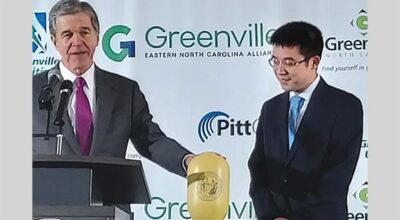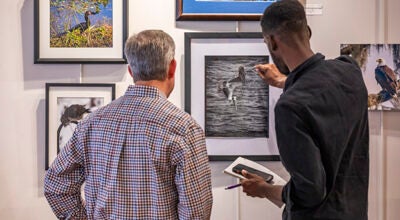STEM EXPOSURE: Local students get glimpse of future opportunities
Published 6:58 pm Monday, November 17, 2014
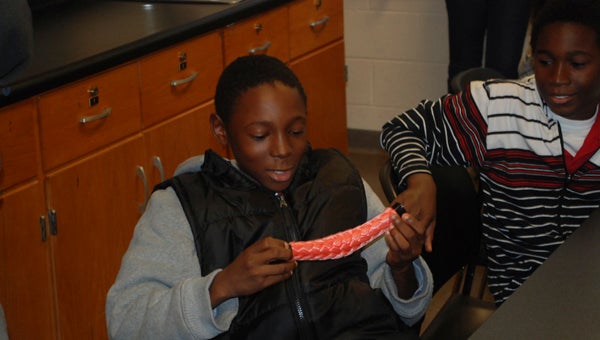
JONATHAN ROWE | DAILY NEWS
APPLYING SCIENCE AND TECHNOLOGY: Friday at Beaufort County Community College, Police Activities League hosted a Life Skills and Career Program, which brought 320 county middle school students to learn about the available science and technology career opportunities. Pictured, Tommy Ebron, a P.S. Jones Middle School 7th-grader, examines a rope made with Dyneema during a DSM presentation Friday at Beaufort County Community College.
Friday, at Beaufort County Community College, 320 middle school students attended a program, exposing them to the vast spectrum of STEM careers available as well as guidance on what pathways to take to pursue those careers.
Hosted through a partnership between the college and the Beaufort County Police Activities League, the event featured a lineup of entities that came out to give students valuable information on the career opportunities in the science, technology, engineering and math fields. The Youth Life Skills and Science and Technology Program brought 300 students from P.S. Jones Middle School and more than 20 students from S.W. Snowden Elementary School were exposed to what seventh-graders should be thinking about as far as a two-year school, what kids should be thinking about from transitioning from a two-year college to a four-year university or going straight to a four-year university from high school, as well as what seventh-graders could be doing to prepare for that by taking science and technology courses while in middle and high school, said Al Powell, PAL director.
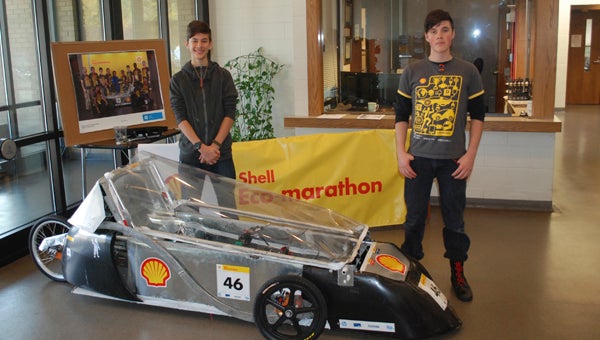
JONATHAN ROWE | DAILY NEWS
INNOVATION: During PAL’s Life Skills and Career Program at BCCC on Friday, middle school students were able to see a Shell Econo Marathon vehicle, built by Camin and Jetsun Randall and their family. The two brothers said the vehicle, which runs on ethanol, could get up to 800 miles per gallon.
PAL gave an opening life skills and career orientation, and the students were broken up into four groups to hear presentations from different participating entities, Powell said. Among those presenters were: NASA Langley Research Center of Hampton, Va., which talked to kids about the aerospace world, research relative to NASA, and what kids could be looking at from a career perspective there; PotashCorp-Aurora, which featured a chemical engineer, Ann Lang, conducting a presentation about the wonders of the engineering and technology professions and careers at the company and academic preparation for that; DSM of Greenville, which talked to kids about their specialization of high-tech fiber manufacturing, ballistic shields, high-tinsel strength fibers and did a lot of show-and-tell with what they produce at their facility; and Elizabeth City State University, which did an aviation and science and technology program, reflecting airplane simulation and software operation of an aircraft and detailed the programs offered at the school, Powell said. Personnel from the U.S. Coast Guard Auxiliary, which is very instrumental in boating safety and integrates science and technology into the PAL programs, were also present.
Samuel James, a mechanical engineering technician with NASA said he gave the students some of his experience as a middle-school student, as well as guidance on the importance of striving to do well in STEM classes.
“What I stressed to the kids here was regardless of what occupation or what career you plan to pursue, you always have to take your higher math and science courses,” James said. “Whether it’s a police officer, doctor, lawyer, there’s no way around it. I also shared with them that as a seventh-grader, when I took Algebra, I didn’t do well — I failed, but I told them, for every successful person, someone has to fail before they succeed. So I plant that in them and say, ‘Just refocus and apply yourself more,’ and that’s what I had to do. I applied myself more in Algebra and ended up getting ‘A’s.’ But, again, we’re not all perfect. You just have to reapply yourself and succeed to overcome that barrier.”
Kevin White, a processing engineering manager at DSM, said his presentation was meant to spark the students’ interest in how science and technology can be applied. His presentation was heavily centered around showing students some of the products designed and manufactured at the Greenville plant site.
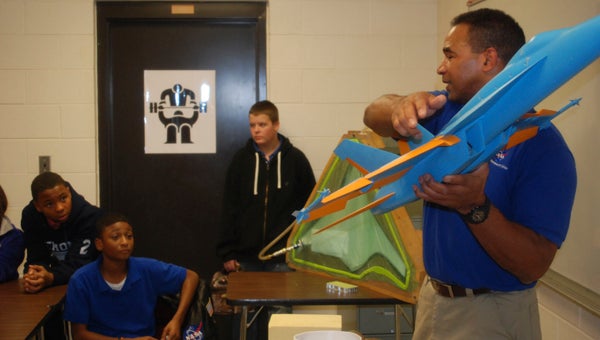
JONATHAN ROWE | DAILY NEWS
AEROSPACE: Pictured, middle school students hear a presentation from Samuel James, a mechanical engineering technician from NASA’s Langley Research Center in Hampton, Va.
“The future is STEM, so anytime we can come out and talk about what we do, it’s pretty interesting stuff,” White said. “Most people don’t know what we do anyway, so the kids really enjoy it. The ballistic piece of it, they really enjoy anyway — it’s really neat, it’s something different. So if you can make a few connections and a few kids take something away, go home, Google Dyneema and learn something and learn what an engineer does because of this, then fantastic. We’ve done our job.”
In addition to the presentations, there were several static displays outside of Building 8 of the BCCC campus, including fire trucks and an 18-wheeler, focusing on robotics and manufacturing applications. There was also a Shell Econo Marathon vehicle, built by a local family, to inspire kids and spark their interest in science and technology applications, Powell said.
“This is the second time we’ve had this event,” Powell said. “We did it in 2012, and it was pretty successful and we were asked to do this again. PAL, because of having so many people with aviation and science and technology backgrounds, we’ve been extensively focusing on nothing but entertaining kids with science and technology and getting them interested and engaged in events like this, which are one-day events, or special programs, which may be 80 hours. So this is just one of our specialty events that we focus, and I can’t say enough about BCCC being willing to host this event so the kids get that exposure to a community college for the first time and it gives BCCC and ECSU a chance for some future collaboration in the science and technology fields.”


